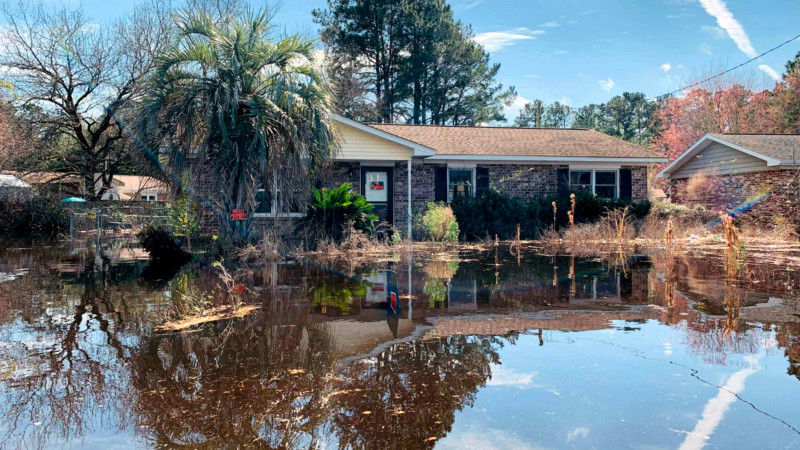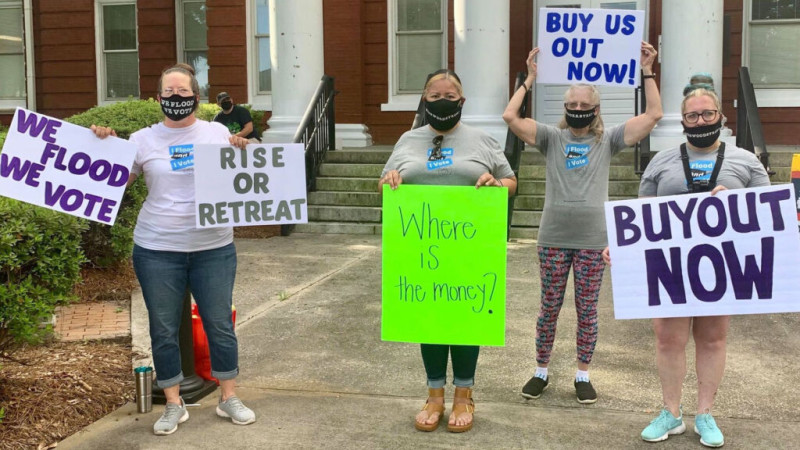The Promise and Challenges of Managed Retreat
From our collaborating partner “Living on Earth,” public radio’s environmental news magazine, an interview by managing producer Jenni Doering with reporter Daniel Shailer on managed retreat in coastal South Carolina.
Coastal and low-lying areas across the U.S. are experiencing increased flooding linked to the climate crisis, leaving homeowners with costly water damage.
South Carolina is facing the reality that in some areas, managed retreat may be the only option. A 2023 resilience report found that the state may need to buy out and tear down roughly 700,000 flood-prone homes.
South Carolina is one of the few states with a dedicated climate resiliency office and a plan for adapting to climate change. In some coastal areas, the state is offering to help homeowners move by buying out homes from residents living in floodplains and turning the land into green space better adapted to absorbing and retaining water.
Explore the latest news about what’s at stake for the climate during this election season.
Daniel Shailer is a freelance climate journalist who reported on this buyout program as part of a climate adaptation series for Inside Climate News. Here’s how this is playing out in the South Carolina town of Socastee. This interview has been edited for length and clarity.
JENNI DOERING: Why is South Carolina so vulnerable to flooding these days?
DANIEL SHAILER: We think of sea level rise as a kind of homogenous, equal threat around the world, but it’s a much more localized thing. And because of the way that ocean currents are changing along the Gulf states on the East Coast, the sea level is actually rising locally at an accelerated rate. So South Carolina is kind of on the front line, along with Florida, North Carolina, of that change, but at the same time, South Carolina, for other reasons is one of the fastest-growing states in the country. Coastal property is on the up: second homes, people moving to the coast.
So those two things in conjunction—more and more people moving into a coastal area that is more and more under threat from sea level rise—that’s one of the reasons that South Carolina and coastal South Carolina are at climate risk.
DOERING: And when you add to that, these storms that can bring intense downpours, that’s a whole other flooding issue as well.
SHAILER: Some scientists like to call them kind of rain bursts or rain bombs, but warmer air holds more moisture. It’s not that there’s more water in the actual water cycle, but when it does rain, it rains in kind of Biblical bursts of huge amounts of rain.
When a rain burst or a rain bomb arrives, there’s less dry, unsaturated earth above the ground level to absorb that water. More water ends up kind of sloshing around on top, flooding houses, interrupting people’s lives.
DOERING: Meanwhile, you say people are moving into this region, even as the state is acknowledging these risks and actually trying to help people move out. Tell me about this home buyout program that South Carolina is embarking on that caters to some of these climate-vulnerable communities. How does this program work?

SHAILER: It’s part of a more broad changing of coastal resiliency strategy. The prevailing wisdom for a while has been, the coast is getting more vulnerable; let’s hunker down.
Hunkering down in a coastal resiliency context looks like sea walls, flood gates, building houses on stilts, basically not budging but getting prepared in some kind of way.
Managed retreat strategy or policy is the idea that instead of hunkering down, we will move back away from the coasts. The most equitable way to do that, when some people can’t afford to just up and move, is to have a kind of buyout.
The state or federal agency offers homeowners some kind of amount pegged to the value of their home, to buy their home from them so that they can relocate somewhere more inland.
South Carolina is, I think it’s fair to say, ahead of the curve compared to other states. They know how many houses they think will need to retreat back. This is how much it might cost. They even have what they call a kind of matrix for looking at not just climate risk in terms of low-lying ground, sea level rise, rain, but also kind of socioeconomic factors about which areas might need more help than others.
Socastee was one of those places.
DOERING: How much money is the state able to offer some of these homeowners when they are trying to get them to move out?
SHAILER: It’s a little bit of a complex question to answer. Managed retreat is a beautifully simple idea in principle: Offer people some money. They just move inland, somewhere safer. Everyone’s happy; that land becomes typically a green space which absorbs floodwater and then becomes a kind of public asset for people to use, playgrounds, that kind of thing.
But in practice, it is almost always a little bit more complicated, if not messy. The funding question depends where the funding is coming from. In South Carolina and in Socastee, the upper cap was around a quarter of a million dollars, with a couple of things that could make it higher or lower but that was basically the cap. Which for some people was more than enough, for some people, was about right. For people who have the really decked-out waterfront houses, it doesn’t come near.
DOERING: The government is offering you money to move, but sometimes the price isn’t right. Melissa Krupa participated in this buyout program; she lived in this community—Socastee, South Carolina—that you wrote about. Tell me about Melissa.
SHAILER: Melissa is a real force of nature. When I first spoke to her, it was kind of at the tail end of a six-year battle for her. First to get a buyout and then to get the state to actually demolish her home like they promised. I’ve got a clip from Melissa talking about what she went through:
“In 2016, my house flooded with three-and-a-half feet of water in my house,” Krupa said. “I did start to remodel and rebuild, and then in 2018 I lost my house again to flooding—five-and-a-half feet of water. At that time I realized I had to do something; I couldn’t keep rebuilding. I didn’t want to live in flood waters, and I knew I had to do something for me and my community because we kept losing our house. Some people in my neighborhood who are closer to the water lost their house like 10 times. That’s when I decided to start speaking up.”
DOERING: So Melissa has this conviction, this strong voice. What does she do to try and help her community and help herself as a homeowner?
SHAILER: The first thing that Melissa does is start casting around among her neighbors, starts looking online and through that she comes across a woman called Harriet Festing. She ran a group at the time, a kind of coalition of maybe 40 or so frontline environmental groups called Anthropocene Alliance that is now well over 300 to 400 groups. But at the time, it was a kind of small organization, and it was Harriet trying to connect groups that were living with climate change already.
This is back in 2018—the beginning of a six-year fight for Melissa and her neighbors. It was only, gosh, only a month ago that her home was actually demolished.

For two-and-a-half years, after getting the buyout, she was ringing up asking, why is my home still up? When is it going to return to green space? That kind of stuff. And even still, Melissa gets calls. She told me Realtors are trying to buy her home that is now a kind of ghost—it doesn’t exist anymore. She’s become a real champion of not just buyouts, but like, equitable community approaches to dealing with climate change.
But it was not an easy road for her. I understand that in Melissa Krupa’s community only one in 10 eligible homeowners initially signed up for this program.
DOERING: Why is that?
SHAILER: For me, that was kind of the driving question behind this story. And I came to the story expecting a little bit of climate denialism maybe, that in a deep red state, kind of semi-rural area, maybe after one or two floods, people weren’t willing to accept that this was a risk that not only is going to continue but get worse.
That was less the case than I was expecting, to be honest. The people that I spoke to were pretty aware of the risks, because they’ve been living with it for so long. What actually emerged was a kind of more complicated combination of things. One of them was definitely a different type of denialism, denialism about the buyout itself, whether that was going to happen, because it took so long. One was also in the time that the buyout came together and then demolition started, there was essentially a kind of pattern of predatory Realtor behavior that we expect was undermining some parts of the buyout.
DOERING: What’s going on there?
SHAILER: There are no federally uniform regulations for flood disclosure when you’re selling a house. But in recent years, different states have taken the initiative to pass laws about what you have to warn people about if you’re selling houses.
South Carolina is ahead of the curve on this and has pretty strong flood disclosure regulations, but the kind of loophole that we expect was emerging in the time between the flooding and the actual buyouts. We looked at property deeds and a lot of these houses from after the flood in 2018 were being sold and then switching hands between, often, companies with similar but slightly different names, between the agents of those companies.
We expect by the time of selling it to a new resident, if the company that’s owned it in the last two or three months hasn’t experienced any flooding, then at least for the flood repairs, flood history in their ownership, they can quote-unquote say that it has not been.

They would still have to take flood risk and so if there were cases where that wasn’t happening, that would be, if not, a gray area, then a manipulation of those disclosure laws. But Melissa saw a lot of the fix and flip behavior firsthand with her neighbors. Here’s another clip from her:
“The house behind me, the original owners … sold it to a flipper. The flipper flipped it. It did not flood in his time, and he sold it to a family, a young family, but the mother had cancer, and they had two young children and within a few months, their house flooded. So here she is dying of cancer, thinking that, you know, she has a home for her children and her husband and now they have no home. And now, not only she’s struggling to fight this cancer battle to stay alive as much as she could. She’s now trying to figure out the flood situation and how to redo her home.”
SHAILER: It’s heartbreaking, really. There’s a hundred personal tragedies, but for the buyout as a whole, you can also see why people that were living there before 2018 could become a part of that.
DOERING: What can be done to break that vicious cycle of flipping these houses, not warning the new homeowners about the risk, and new people move in and get flooded out. Now that South Carolina is embarking on more of these home buyout programs, how can that cycle be stopped?
SHAILER: It’s tricky, and it’s a combination, I suppose, of nuts and bolts policy stuff and hearts and minds persuasion work.
When buyouts happen quicker, there’s more willingness. There was a policy expert who put it really well: A good buyout is like catching lightning in a bottle. If you get there with the money soon after the flood, why wouldn’t someone sign up? After all, the people that participated or sold their houses to realtors were clearly people who were willing to leave. So getting the buyout together more quickly.
[Another one is] tightening up flood disclosure regulations so that there is more transparency, and there are some kind of privacy and genuine real estate concerns with that. But one of the workarounds might be, that a group called the Southern Environmental Law Center are working on, is instead of requiring Realtors to share more of that information, attempting to put together some kind of searchable database of other things that are public information, like neighborhood to neighborhood emergency alerts.
If you could put in an address and see, all right, that neighborhood said there’s a flood coming, get your sandbags out, six times in the last six months, then you know without having to rely on the Realtor, that this is a flood-prone property.
So it’s about tightening up the timeline, strengthening the flood disclosure regulations and then also a kind of snowball. When people begin to see that managed retreat is a real thing and has good outcomes for people, then the next time their neighbor starts talking about managed retreat, talking about a buyout, they’re more likely to seriously consider being a part of that.
About This Story
Perhaps you noticed: This story, like all the news we publish, is free to read. That’s because Inside Climate News is a 501c3 nonprofit organization. We do not charge a subscription fee, lock our news behind a paywall, or clutter our website with ads. We make our news on climate and the environment freely available to you and anyone who wants it.
That’s not all. We also share our news for free with scores of other media organizations around the country. Many of them can’t afford to do environmental journalism of their own. We’ve built bureaus from coast to coast to report local stories, collaborate with local newsrooms and co-publish articles so that this vital work is shared as widely as possible.
Two of us launched ICN in 2007. Six years later we earned a Pulitzer Prize for National Reporting, and now we run the oldest and largest dedicated climate newsroom in the nation. We tell the story in all its complexity. We hold polluters accountable. We expose environmental injustice. We debunk misinformation. We scrutinize solutions and inspire action.
Donations from readers like you fund every aspect of what we do. If you don’t already, will you support our ongoing work, our reporting on the biggest crisis facing our planet, and help us reach even more readers in more places?
Please take a moment to make a tax-deductible donation. Every one of them makes a difference.
Thank you,
David Sassoon
Founder and Publisher
Vernon Loeb
Executive Editor
Share this article
Disclaimer: The copyright of this article belongs to the original author. Reposting this article is solely for the purpose of information dissemination and does not constitute any investment advice. If there is any infringement, please contact us immediately. We will make corrections or deletions as necessary. Thank you.








